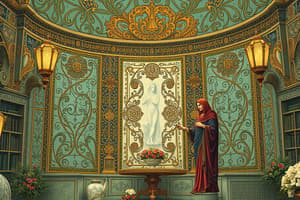Podcast
Questions and Answers
What are the main expressions in both classical and contemporary arts?
What are the main expressions in both classical and contemporary arts?
- Political messages
- Technological advancements
- Abstract ideas
- Human experiences (correct)
Classical art emphasizes diversity in styles and techniques.
Classical art emphasizes diversity in styles and techniques.
False (B)
What does contemporary art frequently engage with?
What does contemporary art frequently engage with?
Current social, political, and cultural issues
Classical Art primarily includes painting, sculpture, architecture, and ______.
Classical Art primarily includes painting, sculpture, architecture, and ______.
Which of the following is a characteristic of contemporary art?
Which of the following is a characteristic of contemporary art?
What is the core purpose of art according to the text?
What is the core purpose of art according to the text?
What defines the Classical Art time period?
What defines the Classical Art time period?
The class system typically divides society into the bourgeoisie (owners) and the ______.
The class system typically divides society into the bourgeoisie (owners) and the ______.
Flashcards are hidden until you start studying
Study Notes
Similarities Between Classical and Contemporary Arts
- Both classical and contemporary arts express human experiences, emotions, and narratives.
- They reflect the cultural and societal contexts of their respective creators and periods.
- Aesthetic qualities are important in both forms, though interpretations of beauty may differ.
- Technical skill is valued in both; classical art emphasizes precise techniques, while contemporary art showcases innovative methods.
- Both art forms are influenced by and reflect the social, political, and cultural environments of their times.
Differences Between Classical and Contemporary Arts
-
Time Period:
- Classical art originates from ancient civilizations, particularly Greek and Roman, and includes the Renaissance.
- Contemporary art emerges from the late 20th century, incorporating modern and postmodern perspectives.
-
Style and Techniques:
- Classical art emphasizes realism, balance, and idealized forms, often focusing on the human figure.
- Contemporary art embraces diverse styles, including abstract and conceptual art, using non-traditional materials and mixed media.
-
Purpose and Themes:
- Classical art typically serves religious, mythological, or historical purposes, celebrating human and divine achievements.
- Contemporary art often addresses current sociopolitical issues, questioning established norms and exploring identity.
-
Mediums Used:
- Classical art primarily consists of painting, sculpture, architecture, and drawing, utilizing materials like marble, bronze, and canvas.
- Contemporary art extends to digital art, installations, performance, video, and interactive media.
-
Audience Engagement:
- Classical art is usually intended for public admiration and often serves religious or state functions.
- Contemporary art encourages active audience participation, emphasizing individual interpretation and perspective.
Marxism
- Definition: A social, political, and economic theory that critiques capitalism and advocates for class struggle and the redistribution of resources.
- Class System: Society is stratified into classes based on wealth and capital ownership, typically distinguishing between the bourgeoisie (owners) and the proletariat (workers).
Studying That Suits You
Use AI to generate personalized quizzes and flashcards to suit your learning preferences.




